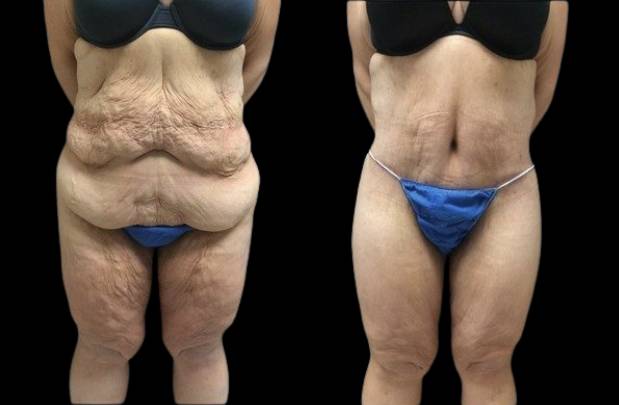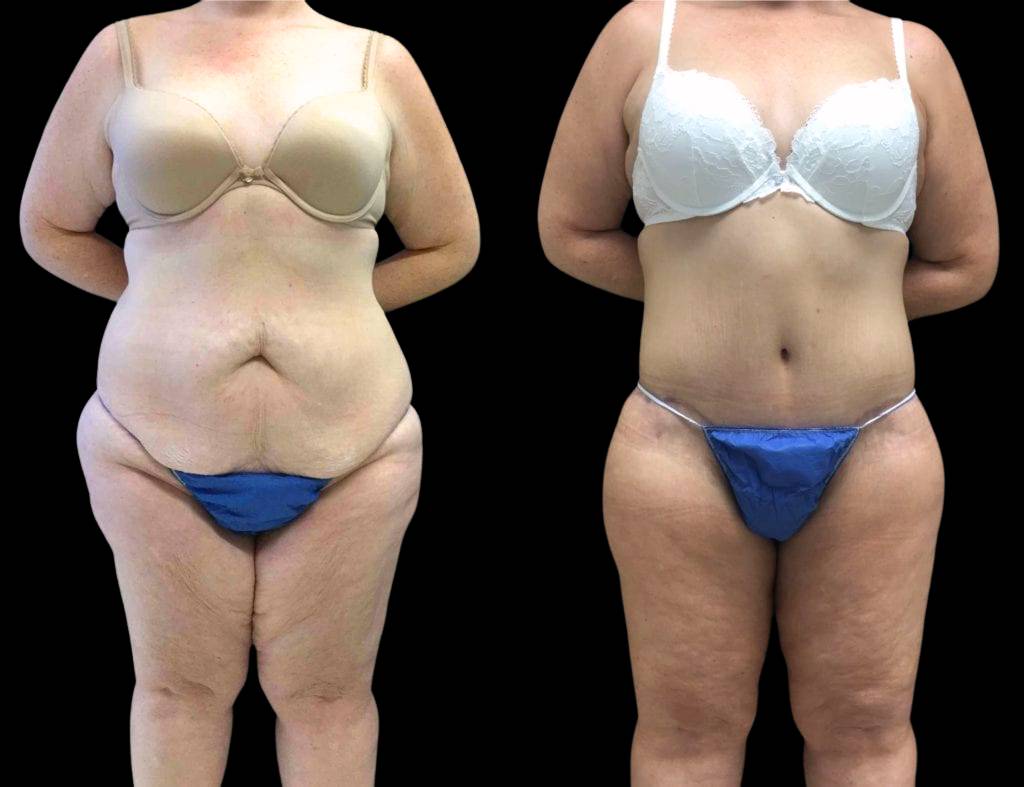Lower Body Lift After Weight Loss
Northern Virginia and Washington DC area
Introduction
One of the biggest advances in plastic surgery in recent years has been the body contouring surgery that we offer to patients who have lost a massive amount of weight. When someone loses a significant amount of weight, the harsh reality is that, in most cases, excess fat is traded for excess skin. Also, several psychological, social, and medical changes occur with the weight loss that a plastic surgeon should acknowledge when deciding what surgery to offer a weight loss patient.
When a patient undergoes dramatic weight-loss, there is usually loose skin in the face, arms, breasts, abdomen, buttocks, and thighs. A lower body lift is an operation that addresses the laxity of skin and excess fat in the abdomen, waist, hips, outer thighs, and buttocks. It can be combined with an inner thigh lift for total lower body rejuvenation. Although it is a big operation with prolonged healing time, the satisfaction a patient gets from this operation and the dramatic improvement is unparalleled.
A lower body lift procedure is more than cosmetic surgery for a bariatric patient. It is part of a “new me” plan. It is an affirmation of a final chapter in a long road towards self-improvement. It is the crowning achievement after taking huge risks, suffering major setbacks, and finally achieving a body that was once felt to be only a dream. It is a plastic surgeons privilege to help a patient achieve this dream.
Pain Level After Surgery
Anesthesia
Duration of Surgery
Scars
Final Results
Return to regular activity
Resume Exercise
Price Range

Preparing For Surgery
An initial consultation is set-up where we discuss the lower body lift procedure, and whether you are a good candidate for the surgery. Your medical history is reviewed, and you will be asked to see your medical doctor for a physical check-up and a few labs to make sure you can undergo the surgery safely. You are given the opportunity to be seen by your own doctor to give the green light for surgery. You are asked to stop smoking, if you are a smoker, two weeks before and two weeks after surgery, for the surgery to be performed safely, and for you to have optimal results. You are given the opportunity to talk to patients who have had the same surgery you are considering. We will see you shortly after the surgery (in a day or two usually). You are always welcome to come back for follow-up, even years after your surgery, free of charge.
Patients seeking lower body lift surgery are usually bariatric surgery patients. They need to understand that massive weight loss, especially after a gastric bypass, puts them at a higher risk of complications from any surgery, especially a big one, like a lower body lift. All efforts to optimize nutrition, body weight, muscle tone, psychological, and mental state of mind should be undertaken to ensure the best outcome possible.
The Lower Body Lift Procedure
This procedure is a big operation. It usually lasts about 6 hours and the patient has significant bleeding when compared to other plastic surgery procedures. Therefore, we request patients to have either themselves or relatives donate a total of 2 pints of blood that will be given back to them during the operation. Also, this is the only procedure that we require our patients to stay in the hospital for two days.
Conceptually, a lower body lift procedure is simple to understand. Imagine removing a 6 inch belt of skin around your waistline and lifting the lower body to fill the gap. This is a simplistic rendition of what a lower body lift accomplishes. This procedure will tighten the abdomen, waist, hips, buttocks, and outer thighs. It will not improve the inner thighs but it can be combined, in the appropriate patient, with an inner thigh lift, to accomplish a complete lower body enhancement.
The scar in this operation is of major concern. The location varies depending on the patient, but it usually resembles a bikini bottom pattern. Because of the high satisfaction that this procedure yields, patients are accepting of the extensive circumferential scar.
Before and After Photos


“Wonderful experience! You always feel like you are the priority. Doctor Bitar and his staff make you feel like you are a part of their family! Top notch professionals and although early in post surgery recovery my results to this point are amazing!”
– Dana A.
How We Minimize Complications Of Lower Body Lifts:
At the Bitar Cosmetic Surgery Institute, we take pride in making sure we provide for our patients the best surgical experience possible , anticipating problems or set-backs, and addressing them before they happen. This is a process that includes the pre-operative preparation, the actual surgery, and the after care.
General Complications
General complications can occur with any surgery. Cosmetic surgery is usually a safe surgery performed on healthy patients and, as all surgeries go, is with low risk. What we do to even lower the risk of complications is to operate at a first class hospital with board certified anesthesiologists and nurses. To avoid post-operative complications, we advocate early mobilization –patients seen in our office one or two days after surgery- and active participation in their own post-operative care. When we create a partnership, the results invariably improve.
Bleeding
Bleeding during and after a lower body lift is significant, and a patient is usually given 2 pints of blood. Before surgery, our patients are tested to make sure they don’t have any common bleeding disorders by their own physicians, and by lab tests. Also, at the end of the operation, four-six drains are placed under the skin to manage any early post-operative bleeding. In our practice the rate of significant bleeding is about 10%. These patients may require more blood post-operatively. The treatment of a hematoma or a blood clot under the waistline skin is to open the incision and evacuate the blood clot. Typically this is a straightforward procedure.
Infection/Wounds
The most important step in avoiding infections/wounds, in my opinion, is to perform the surgery at a first-rate surgical facility with board certified anesthesiologists and nurses. Patients are given the appropriate intravenous antibiotics coverage throughout the surgery and during the two day hospital stay. During the surgery, the skin surface of the patient is cleaned properly. After the procedure, our patients are prescribed a two-week course of antibiotics to minimize infection. As a result of these extra precautions, our rate of infection after a lower body lift is low. Conservative removal of skin is important for good aesthetic results, while avoiding undue tension on the skin. Small to moderate wounds, due to the nature of this operation, may be as high as 25% in our practice. They usually heal nicely with dressing changes and antibiotic ointment. The key to a good outcome is patience on behalf of the patient, and good communication and follow-up with our office.
Nerve Injury
By elevating the skin of a large area in the waist region to perform a lower body lift, the nerves that provide sensation to the areas around the waistline are cut, and sensation over most of the abdomen and the buttocks is lost for months. After a year, sensation usually returns, but not completely. This fact is significant for patients to understand so that they will not put heating pads or cold compresses on their waist after surgery because with nerve sensation absence, a burn may occur.
Seromas (Fluid Collection under the Skin)
When a large area of skin is undermined, fluid collects underneath. Drains are placed to evacuate this fluid. After drains are removed, fluid may reaccumulate. The treatment is to aspirate the fluid, which is usually sterile, with a needle. This may need to be done multiple times over a few weeks. This maneuver is not dangerous, or painful, but it is a nuisance, requiring more frequent office visits than normal. The rate of seromas in our lower body lift patients is about 20%.
Smoking is an absolute contraindication in lower body lift. The carbon monoxide and nicotine in cigarette smoke causes severe reduction in blood supply to the skin and tissue during healing. This results in delayed wound healing, wound separation, death of the skin, and a higher risk of infection. Cotinine testing is performed in patients with a smoking history to ensure that they are safe when having this procedure.
Post-Operative Care
Our office will provide you with a detailed post-operative instruction sheet that will be individualized to your needs. We usually see patients the day after surgery in one of our offices to make sure that everything is O.K., and that you are healing as planned. Multiple visits in the year after the procedure will ensure the best outcome possible.
For more information about this procedure call our office and speak to our friendly staff member at 703-206-0506.
Related Articles
Special Surgery, Unique Patients
“Understanding the characteristics of massive weight loss patients is as important as operating on them”
Extreme Makeovers: Plastic Surgery After Massive Weight Loss
“We have all seen on TV the shows “Extreme Makeovers” or “The Swan”, whether we have admitted it to our friends or not. The concept is, without a doubt, fascinating…”
Information on this web site is for information only. Do not use the information to diagnose or treat your plastic surgery or cosmetic surgery problems. Please contact your plastic surgeon with all questions and concerns.
Contact Our Office For A Consultation
If you would like further information regarding this procedure, please feel free to contact our office to schedule an appointment by calling (703) 206-0506 or filling out an online request form.
“Natural beauty but doing a little somethin’ somethin’ to make beautiful features pop is what the Model Lift™ accomplishes.”
Dr. George Bitar
